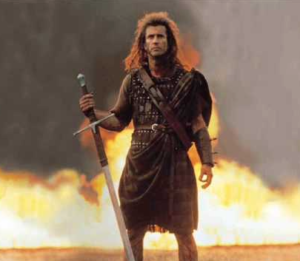 The 1995 hit movie Braveheart depicted the Scottish people’s struggle for freedom against England and was centered around the Scotts hero, William Wallace. The movie’s first large battle pitted the English army against the smaller, less well-trained and equipped Scottish army at Stirling in the 1297. The English were based on the south side of the river Forth, near Stirling castle and Stirling bridge, while the Scots were north of the river, camped upon Abbey Craig. While the movie version of the battle and the terrain it was fought upon was not accurate, the outcome was the same – the first Scottish victory against the English army.
The 1995 hit movie Braveheart depicted the Scottish people’s struggle for freedom against England and was centered around the Scotts hero, William Wallace. The movie’s first large battle pitted the English army against the smaller, less well-trained and equipped Scottish army at Stirling in the 1297. The English were based on the south side of the river Forth, near Stirling castle and Stirling bridge, while the Scots were north of the river, camped upon Abbey Craig. While the movie version of the battle and the terrain it was fought upon was not accurate, the outcome was the same – the first Scottish victory against the English army.
The English army consisted of the usual mix of infantry, archers and heavy cavalry. The small Scots army was of a similar mix, however their cavalry could not be considered “heavy” in the English sense of the term, having much less armor and inferior weapons.
To this point in history, no army had been able to withstand the charge of heavy cavalry and the English depended on this being the case at Stirling. William Wallace and the Scottish noble, Andrew de Moray, knew this as well and devised a plan to defeat the English army using what was considered at the time to be a very unconventional tactic. Using the terrain and a new weapon, 12 foot long poles as thick as a man’s leg, sharpened on one end, Wallace and de Mornay were able to defeat the English and demonstrate that infantry, under the right circumstances, could turn back and defeat heavy cavalry.
The English were in a hurry to engage and defeat the Scottish army, choosing to cross the river via Stirling Bridge, a narrow structure wide enough to allow only two men riding abreast of each other at a time, rather than moving the army to a nearby ford that would have allowed sixty riders abreast to cross at the same time.
 The bridge was built in the middle of a large loop in the river, which created a narrow opening on the northern side, made up of soft marshy ground. A narrow causeway ran across the soft ground on the northern side and this is where the English army gathered as it slowly crossed the river.
The bridge was built in the middle of a large loop in the river, which created a narrow opening on the northern side, made up of soft marshy ground. A narrow causeway ran across the soft ground on the northern side and this is where the English army gathered as it slowly crossed the river.
The Scots watched for several hours as the English crossed and when a large enough force had gathered that the Scots felt they could still defeat, the Scottish plan was put into action. The Scots came quickly down from the Craig, across the causeway, wielding the large poles and driving the English cavalry onto the soft marshy ground. Surrounded on three sides by the river and on the fourth by the attacking Scottish army, the English army soon fell in to chaos, unable to marshall their cavalry for a coordinated charge in the soft ground. The English could neither retreat nor defend themselves and were soon slaughtered. The remainder of the English army, on the south side of the bridge, burned the bridge, retreated in terror and surrendered the entire area to the Scots, marking the first Scottish victory.
Here again we see the three elements of an underdog using unconventional tactics to win and achieve their goals. 1) It required lots of work and physical effort – the Scottish had to expend considerable effort to fashion their crude long poles from what must have been several hundred trees and then charge the English army with them. 2) A willingness to do what others were not – they were willing to not only fight the English but attack it. 3) The ability to reject social approval – not only was standing up to and fighting the English monarchy considered to be folly and suicidal, Wallace and his army did not fight a gentlemanly battle in the usual, agreed upon manner.
